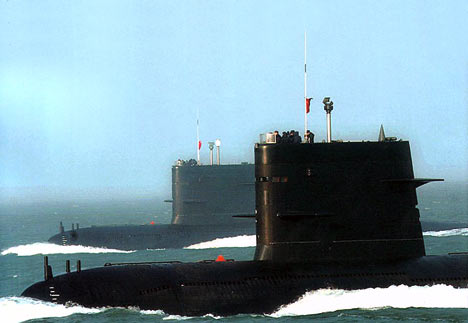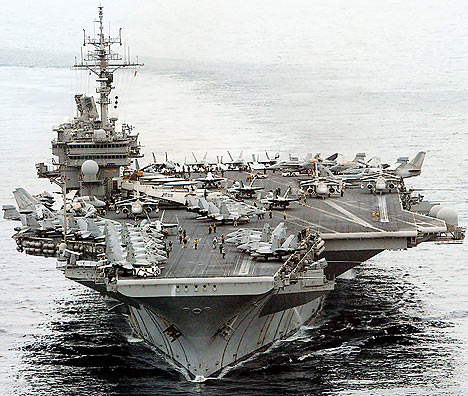
by Matthew Hickley
10 November 2007
from
DailyMail
Website
When the U.S. Navy deploys a battle fleet on
exercises, it takes the security of its aircraft carriers very seriously
indeed.
At least a dozen warships provide a physical guard while the technical
wizardry of the world's only military superpower offers an invisible shield
to detect and deter any intruders.
That is the theory. Or, rather, was the theory...

Uninvited guest
A Chinese Song Class
submarine,
like the one that
surfaced by the U.S.S. Kitty Hawk
American military chiefs have been left
dumbstruck by an undetected Chinese submarine popping up at the heart of a
recent Pacific exercise and close to the vast USS Kitty Hawk - a 1,000ft
super-carrier with 4,500 personnel on board.
By the time it surfaced the 160ft (50m about)
Song Class diesel-electric attack submarine
is understood to have sailed within viable range for launching torpedoes or
missiles at the carrier. According to senior NATO officials the incident
caused consternation in the U.S. Navy.
The Americans had no idea China's fast-growing submarine fleet had reached
such a level of sophistication, or that it posed such a threat.
One NATO figure said the effect was "as big a shock as the Russians
launching Sputnik" - a reference to the Soviet Union's first orbiting
satellite in 1957 which marked the start of the space age.
The incident, which took place in the ocean between southern Japan and
Taiwan, is a major embarrassment for the Pentagon.

Battle stations
The Kitty Hawk carries 4,500
personnel
The lone Chinese vessel slipped past at least a
dozen other American warships which were supposed to protect the carrier
from hostile aircraft or submarines.
And the rest of the costly defensive screen, which usually includes at least
two U.S. submarines, was also apparently unable to detect it.
According to the NATO source, the encounter has forced a serious re-think of
American and NATO naval strategy as commanders reconsider the level of
threat from potentially hostile Chinese submarines.
It also led to tense diplomatic exchanges, with shaken American diplomats
demanding to know why the submarine was "shadowing" the U.S. fleet while
Beijing pleaded ignorance and dismissed the affair as coincidence.
Analysts believe Beijing was sending a message to America and the
West demonstrating its rapidly-growing military capability to threaten
foreign powers which try to interfere in its "backyard".
The People's Liberation Army Navy's submarine fleet includes at least two
nuclear-missile launching vessels. Its 13
Song Class submarines are extremely quiet
and difficult to detect when running on electric motors.
Commodore Stephen Saunders, editor of Jane's Fighting Ships,
and a former Royal Navy anti-submarine specialist, said the U.S. had paid
relatively little attention to this form of warfare since the end of the
Cold War.
He said:
"It was certainly a wake-up call for the
Americans.
"It would tie in with what we see the Chinese trying to do, which
appears to be to deter the Americans from interfering or operating in
their backyard, particularly in relation to Taiwan."
In January China carried a successful missile
test, shooting down a satellite in orbit for the first time.


